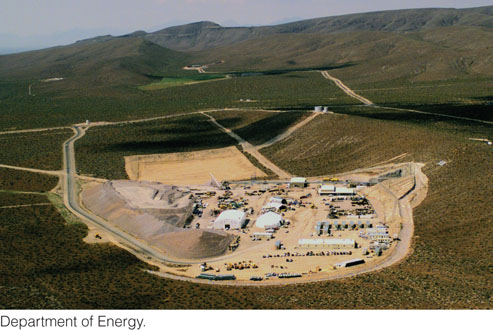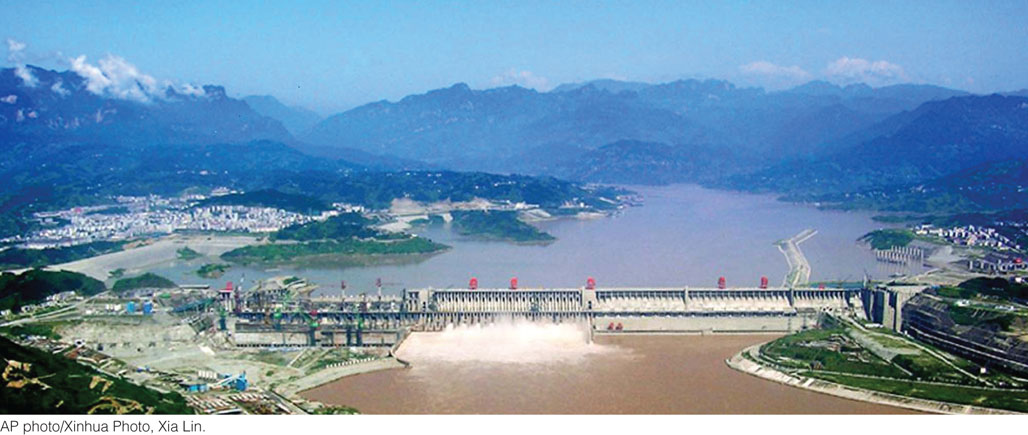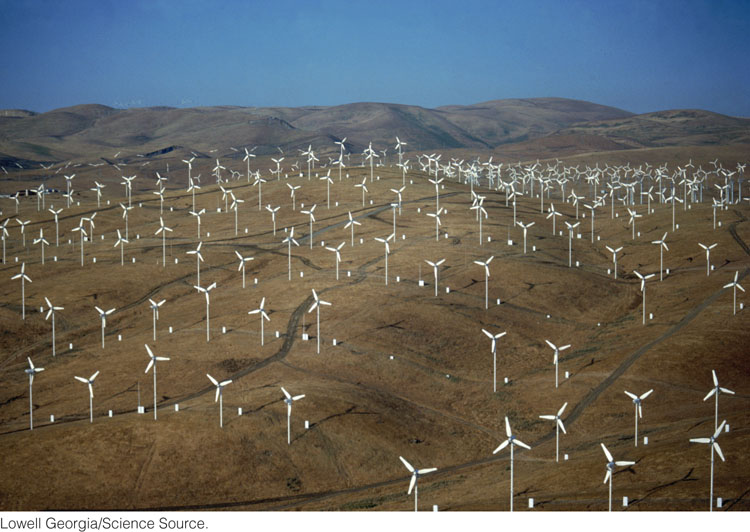Alternative Energy Resources
As we continue to deplete our fossil-fuel resources, alternative energy resources will have to take up more and more of the demand. How quickly will this transition to a postpetroleum economy occur? Which alternative sources of energy have the greatest potential to replace fossil fuels?
Nuclear Energy
The first large-scale use of the radioactive isotope uranium-235 to produce energy was in the atomic bomb in 1944, but the nuclear physicists who first observed the vast energy released when its nucleus split spontaneously (a phenomenon called fission) foresaw the possibility of peaceful applications of this new energy source. After World War II, countries around the world built nuclear reactors to produce nuclear energy. In these reactors, the fission of uranium-235 releases heat that is used to make steam, which then drives turbines to create electricity. A typical commercial reactor produces about 1000 megawatts of electricity (1 megawatt = 1 million watts). Large nuclear facilities may have multiple reactors (Figure 23.20).
656

Nuclear power supplies a substantial fraction of the electric energy used by some countries, such as France (75 percent in 2012), Slovakia (54 percent), and Sweden (38 percent), but this proportion is much smaller in the United States (19 percent). Overall, the nation’s 110 nuclear reactors account for about 8.5 percent of total U.S. energy demand (see Figure 23.14). The early expectation that nuclear fuels would provide a large, low-cost, environmentally safe source of energy has not been realized, primarily because of problems with reactor safety, disposal of radioactive wastes, and nuclear security.
Uranium Reserves
Uranium is found as a trace element in some granites at an average concentration of only 0.00016 percent of the rock. Moreover, only a small proportion of uranium is uranium-235; its other, much more abundant isotopes (for example, uranium-238) are not radioactive enough to be used as fuel. Uranium is nevertheless the world’s largest minable energy resource by far, with a potential energy-generating capacity of at least 240,000 quads, much larger than any fossil fuel. Minable concentrations are typically found as small quantities of uraninite, a uranium oxide mineral (also called pitchblende), in veins in granites and other felsic igneous rocks. Where groundwater is present, uranium in igneous rocks near Earth’s surface may oxidize and dissolve, be transported in groundwater, and later be reprecipitated as uraninite in sedimentary rocks.
Hazards of Nuclear Energy
The biggest drawbacks of nuclear energy are concerns about the safety of nuclear reactors, the risk of environmental contamination with radioactive material, and the potential use of radioactive fuels for making nuclear weapons.
In the United States, damage to a reactor at the Three Mile Island reactor in Pennsylvania in 1979 released radioactive debris. Although very little radioactive fuel left the containment building, and no one was harmed, it was a close call. Much more serious was the destruction of a nuclear reactor in the town of Chernobyl, Ukraine, in 1986. The reactor went out of control because of poor design and human error. A plume of radioactive debris was carried by winds over Scandinavia and western Europe. Contamination of buildings and soil has made hundreds of square miles of land surrounding Chernobyl uninhabitable. Food supplies in many countries were contaminated by the radioactive fallout and had to be destroyed. Deaths from cancer caused by exposure to the fallout may be in the thousands.
The most serious disaster occurred when the tsunami from the great Tohoku earthquake of March 11, 2011, inundated the Fukushima Daiichi nuclear power plant on the northeastern coast of Honshu, Japan (see Figure 13.31). The reactors shut down, as designed, but the tsunami destroyed the backup diesel generators, cutting power to the water pumps that were supposed to cool the still-hot reactors. Three of the six reactors suffered complete or partial meltdowns, and explosions of hydrogen gas generated during the meltdowns destroyed the reactor containment buildings, releasing radioactive debris into the atmosphere. Water sprayed to cool the damaged reactors carried radioactive material into the ocean. Radioactive materials from these reactors are still leaking into the environment.
657
The uranium consumed in nuclear reactors leaves behind dangerous radioactive wastes. A system of safe long-term waste disposal is not yet available, and reactor wastes are being held in temporary storage facilities at reactor sites. (Spent fuel rods stored on site contributed to the radioactive debris released at Fukushima.) Many scientists believe that geologic containment—the burial of nuclear wastes in deep, stable, impermeable rock formations—would provide safe storage of the most dangerous wastes for the hundreds of thousands of years required before they decay. France and Sweden have built underground nuclear waste repositories. A national repository, the Yucca Mountain Nuclear Waste Repository, was being developed in the United States at Yucca Mountain, Nevada (Figure 23.21), but local opposition caused the federal government to terminate funding for the site in 2010. At present the United States has no long-term plan for nuclear waste disposal.

Biofuels
Before the coal-fired industrial revolution of the mid-nineteenth century, the burning of wood and other biomass derived from plants and animals satisfied most of society’s energy needs. Even today, the energy derived from biomass exceeds the total derived from all other renewable resources.
Biomass is an attractive alternative to fossil fuels because, at least in principle, it is carbon-neutral; that is, the CO2 produced by the combustion of biomass is eventually removed from the atmosphere by plant photosynthesis and used to produce new biomass. In particular, liquid biofuels derived from biomass, such as ethanol (ethyl alcohol: C2H6O), could replace gasoline as our main automobile fuel.
The use of biofuels in transportation is hardly new. The first four-stroke internal combustion engine, invented by Nikolaus Otto in 1876, ran on ethanol, and the original diesel engine, patented by Rudolf Diesel in 1898, ran on vegetable oil. Henry Ford’s Model T car, first produced in 1903, was designed to operate on ethanol. But soon thereafter, petroleum from the new reserves discovered in Pennsylvania and Texas became widely available, and cars and trucks were converted almost entirely to petroleum-based gasoline and diesel fuel.
Ethanol can be mixed with gasoline to run most car engines built today. It is produced mainly from corn in the United States and from sugarcane in Brazil. For the last 35 years, the Brazilian government has been pushing to replace imported oil with domestic ethanol; in 2012, about 35 percent of Brazil’s automobile fuels came from sugarcane, saving the country about $50 billion in oil imports. In 2012, Brazil and the United States accounted for 68 percent of the global biofuel production.
A promising biomass crop is switchgrass, a perennial plant native to the Great Plains (Figure 23.22). Switchgrass has the potential to produce up to 1000 gallons of ethanol per acre per year, compared with 665 gallons for sugarcane and 400 gallons for corn, and it can be cultivated on grasslands of marginal utility for other types of agriculture. Nevertheless, biofuel production competes with food production, so increasing the former drives up the price of the latter, which reduces the economic benefits of biofuels.

658
What about the environmental benefits of biofuels? Can they really be carbon-neutral? If the energy used to fertilize plants, transform them into biofuels, and deliver the biofuels to market comes primarily from fossil fuels, then the answer is no. The widespread use of biofuels for transportation would no doubt reduce the pumping of carbon from the lithosphere to the atmosphere, but experts are still arguing about the magnitude of that reduction.
Solar Energy
Solar energy enthusiasts remind us that “every hour Earth receives from sunlight more energy than human civilization uses in one year.” Solar energy is the prime example of a resource that cannot be depleted by usage: the Sun will continue to shine for at least the next several billion years. Although using solar energy to hear water for homes, industries, and agriculture is economically profitable with existing technology, the methods for the large-scale conversion of solar energy into electricity are still inefficient and expensive. Nevertheless, the solar generation of electricity is increasing rapidly as large power plants are being built in response to voter mandates and government subsidies. The Ivanpah solar electric generating system in California’s Mojave Desert, commissioned in 2013, is the world’s largest, capable of producing up to 392 megawatts of electricity (Figure 23.23).

In the United States, solar energy conversion rose from 0.065 quad in 2004 to almost 0.20 quad in 2012, a threefold increase in just over 8 years. Yet this amounts to only 0.2 percent of U.S. energy consumption. Optimistic projections are that, worldwide, solar conversion could increase to as much as 12 quads per year in a decade or so, which would amount to about 2 percent of total energy production.
Hydroelectric Energy
Hydroelectric energy is derived from water moving under the force of gravity to drive turbines that generate electricity. Artificial reservoirs behind dams usually provide the water. Hydroelectric energy depends on the Sun, whose energy drives the climate system and produces rainfall; thus, like solar energy, it is renewable. It is also relatively clean, risk-free, and cheap to produce.
The Three Gorges Dam on the Yangtze River in China (Figure 23.24) is the world’s largest hydroelectric facility. It is capable of generating 22,500 megawatts—nearly 5 percent of China’s total electricity demand. The project has been controversial, however, because the damming of the Yangtze caused flooding that has displaced over a million people.

In the United States, hydroelectric dams deliver about 2.7 quads annually, or a little less than 3 percent of the nation’s annual energy consumption. The U.S. Department of Energy has identified more than 5000 sites where new hydroelectric dams could be built and operated economically. Such expansion would be resisted, however, because the dams would drown farmlands and wilderness areas under artificial reservoirs while adding only a small amount of energy to the U.S. supply. For this reason, most energy experts expect that the proportion of the nation’s energy produced by hydroelectric power will actually decline in the future.
Wind Energy
Wind power is produced by using windmills to drive electric generators (Figure 23.25). Today, the generation of electricity by high-efficiency wind turbines is a fast-growing source of renewable energy. Wind farms containing hundreds of turbines can produce as much electric power as a mid-sized nuclear power plant. Worldwide, the amount of wind-generated electric power grew tenfold between 2000 and 2010. Denmark now produces 21 percent of its electric power by wind; Portugal, 18 percent. In the United States, electricity from wind sources increased threefold from 2005 to 2010, and wind now accounts for about 1.4 percent of all U.S. energy production (see Figure 23.5).

659
The U.S. Department of Energy estimates that winds sufficient for power generation blow across 6 percent of the land area of the continental United States, and that those winds have the potential to supply more than one and a half times the nation’s current electricity demand. But harvesting this energy would require placing millions of windmills, each 100 m tall, across hundreds of thousands of square kilometers of land. Changes to the landscape required for industrial wind farming, as well as the low-frequency noise generated by the turbines, have made the siting of new facilities a controversial environmental issue in some regions.
660
Geothermal Energy
Earth’s internal heat can be tapped as a source of geothermal energy, as we described in Chapter 12. According to one Icelandic estimate, as much as 40 quads of electricity could be generated each year from accessible geothermal energy sources, but so far only a tiny fraction of that amount, about 0.3 quad per year, is actually being generated. Another 0.3 quad of geothermal energy is used for direct heating. At least 46 countries now use some form of geothermal energy.
Although geothermal energy is unlikely to replace petroleum as a major source of power, it may help to meet our future energy needs. Like most of the other energy sources we have looked at, geothermal energy presents some environmental problems. Regional ground subsidence can occur if hot groundwater is withdrawn without being replaced. In addition, hydrothermal waters can contain salts and toxic materials dissolved from the hot rock. As in the case of fracking, the disposal of these waste waters by reinjection into the crust can trigger earthquakes.